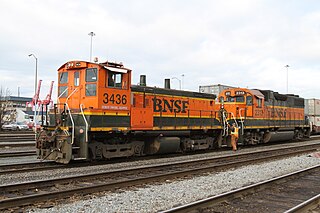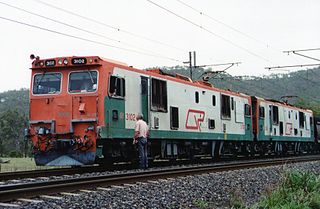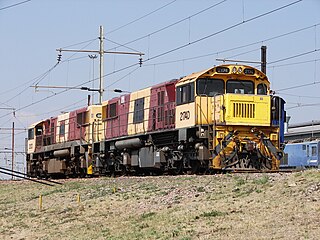
In rail transport, distributed power (DP) is a generic term referring to the physical distribution—at intermediate points throughout the length of a train—of separate motive power groups. Such "groups" may be single units or multiple consists, and are remotely controlled from the leading locomotive. The practice allows locomotives to be placed anywhere within the length of a train when standard multiple-unit (MU) operation is impossible or impractical. DP can be achieved by wireless or wired (trainlined) means. Wired systems now provided by various suppliers use the cabling already extant throughout a train equipped with electronically controlled pneumatic brakes (ECP).

The AC6000CW is a 6,000-horsepower (4,500 kW) diesel electric locomotive built between 1995 and 2001 by GE Transportation. It is among the world's most powerful single-engined diesel locomotives. The locomotive was designed for extremely high horsepower needs, such as pulling heavy coal and ore trains. Most examples were purchased by two railroads: Union Pacific and CSX.
Electronically controlled pneumatic brakes are a type of railway braking systems.

A remote control locomotive is a railway locomotive that can be operated with a remote control. It differs from a conventional locomotive in that a remote control system has been installed in one or more locomotives within the consist, which uses either a mechanical or radio transmitter and receiver system. The locomotive is operated by a person not physically located at the controls within the confines of the locomotive cab. They have been in use for many years in the railroad industry, including industrial applications such as bulk material load-out, manufacturing, process and industrial switching. The systems are designed to be fail-safe so that if communication is lost the locomotive is brought to a stop automatically.

The length of a train may be measured in number of wagons or in metres for general freight. Train lengths and loads on electrified railways, especially lower voltage 3000 V DC and 1500 V DC, are limited by traction and power considerations. Drawgear and couplings can also be a limiting factor, along with curves, gradients and crossing loop lengths.

The C44aci is a model of Australian heavy duty diesel electric locomotive designed by UGL Rail and built at the Broadmeadow factory. It is operated by a number of rail freight operators. The design is based on the National Rail NR class but with some modifications and upgraded features.

The Hamersley & Robe River railway, majority-owned by Rio Tinto, and operated by its subsidiary Pilbara Iron, is a private rail network in the Pilbara region of Western Australia for the purpose of carrying iron ore. The network is larger than any other Australian heavy freight rail network in private ownership. The total length of its track is about 1,700 km (1,056 mi).

The Goldsworthy railway, owned and operated by BHP, is a private rail network in the Pilbara region of Western Australia built to carry iron ore. It is one of two railway lines BHP operates in the Pilbara, the other being the Mount Newman railway.

The Transnet Freight Rail Class 15E of 2010 is a South African electric locomotive.

The GT42CU ACe is a model of diesel electric locomotives manufactured by EDi Rail, Maryborough between 2007 and 2013 under licence from Electro-Motive Diesel, for use on narrow gauge railways in Queensland, South Australia and Western Australia.

The South African Railways Class 9E, Series 1 of 1978 is an electric locomotive.

The South African Railways Class 34-500 of 1974 is a diesel-electric locomotive.

The Mount Newman railway, owned and operated by BHP, is a private rail network in the Pilbara region of Western Australia built to carry iron ore. It is one of two railway lines BHP operates in the Pilbara, the other being the Goldsworthy railway.

The Fortescue railway, owned and operated by Fortescue Metals Group (FMG), is a private rail network in the Pilbara region of Western Australia built to carry iron ore. It opened in 2008. When it was completed, it was the heaviest haul railway in the world, designed for 40 tonne axle loads, 2.5 to 5 tonnes heavier than the other Pilbara iron ore rail systems. On 4 November 2014, FMG Rail commenced trialling 42-tonne axle loads.

The Transnet Freight Rail Class 43-000 of 2011 is a South African diesel-electric locomotive.

The 3100/3200 class are a class of electric locomotives built by Comeng Rocklea and Hitachi for Queensland Rail between 1986 and 1989.

The Queensland Railways 2170 class is an Australian diesel-electric locomotive.
The Railways in the Pilbara are a collection of railways in the Pilbara region of north-west Western Australia.
The BHP Whyalla Tramway is a 1067 mm gauge heavy-haul railway, 112 kilometres long, on the Eyre Peninsula in South Australia. It runs from haematite mines at Iron Monarch, Iron Baron and Iron Duke in the Middleback Range, about 50 kilometres west of Whyalla, to company steelworks at the coastal city of Whyalla. Opened in 1901, it was built by, and until 2000 operated by, the Broken Hill Proprietary Company (BHP). As of 2021 it was owned by Liberty House Group and operated on its behalf by rail operator One Rail Australia, which was sold in 2022 to Aurizon.
















